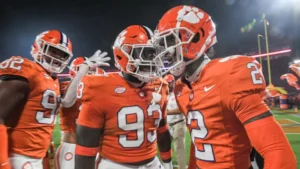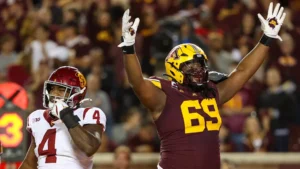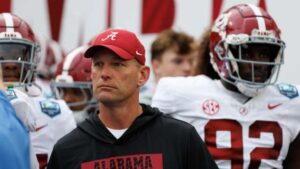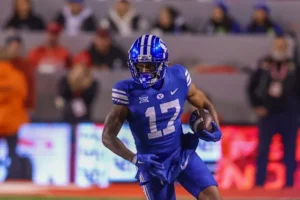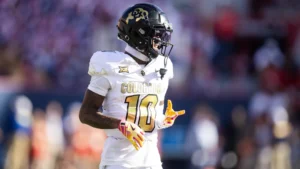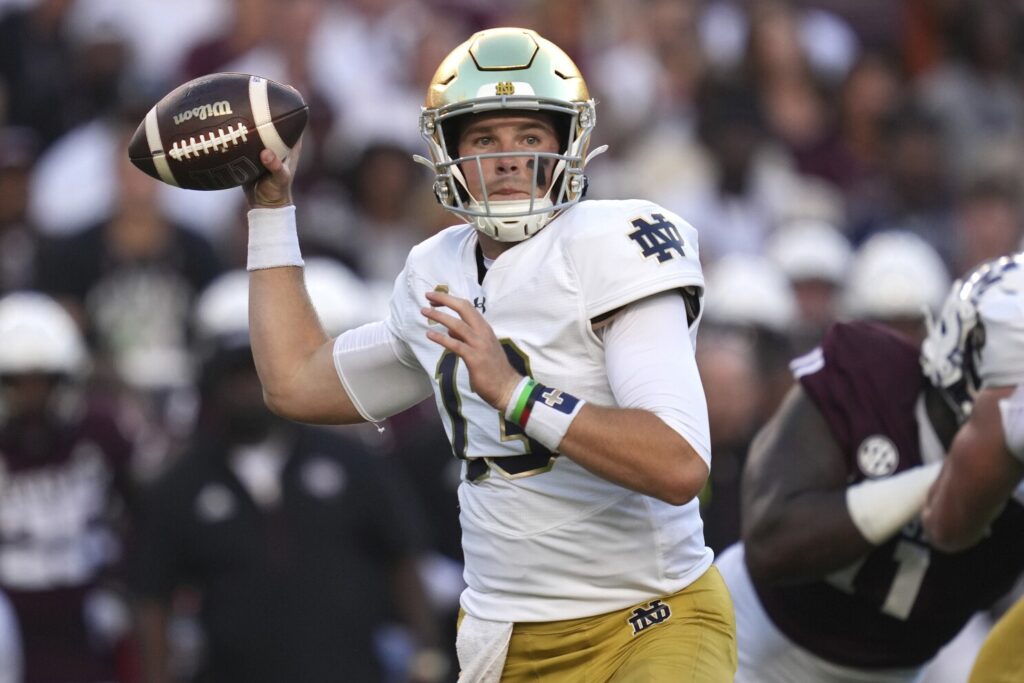
Notre Dame quarterback Riley Leonard (13) passes the ball against the Texas A&M during the first half of an NCAA college football game Saturday, Aug. 31, 2024, in College Station, Texas. (AP Photo/Sam Craft)
The Little-Known Aspect of Notre Dame’s Quarterback Reorganization
By all accounts, Notre Dame’s quarterback situation entering the 2025 season looks vastly different from what it was just a year ago. With Sam Hartman’s departure to the NFL and a reshuffling of the depth chart, the Fighting Irish are in the middle of a significant quarterback reorganization. The headlines have mostly centered around the competition between ascending talents like CJ Carr and Steve Angeli, but what’s largely gone unnoticed is the underlying shift in strategy that’s driving the reorganization — a recalibration of identity that reflects both head coach Marcus Freeman’s evolving vision and new offensive coordinator Mike Denbrock’s fingerprints.
This quiet revolution at the game’s most critical position isn’t just about finding the next starter. It’s about aligning quarterback traits with a broader philosophical change — one that embraces flexibility, playmaking, and schematic multiplicity. And at the heart of this transition is a strategic dimension that few outside the program have fully appreciated.
The Quarterback Room: A Glance at the Surface
On paper, the situation seems straightforward. Hartman’s graduation left a hole under center, and returning backup Steve Angeli, redshirt freshman Kenny Minchey, and five-star true freshman CJ Carr are all vying for the spot. Angeli, who was steady in relief duty last season and led a clean spring game performance, has the edge in experience. Minchey brings raw arm talent, and Carr arrives with sky-high expectations and elite pedigree.
But to reduce the quarterback reorganization to just a three-man competition would be missing the forest for the trees. The decisions Notre Dame is making behind the scenes — who gets reps, how the offense is being tailored, and what leadership traits are being emphasized — point to a deeper evolution.
Mike Denbrock’s Return Signals Philosophical Shift
Notre Dame’s reunion with Denbrock, who previously served as offensive coordinator under Brian Kelly, marks a defining shift. Denbrock, fresh off success at LSU with Jayden Daniels, brings an offense rooted in quarterback mobility, RPO (run-pass option) concepts, and vertical shot plays. The offensive scheme is no longer rigid or tied to classic pro-style execution; it’s designed to adapt to the quarterback’s strengths.
At LSU, Denbrock unlocked Daniels’ full potential by tailoring the system around his dual-threat capabilities. While Notre Dame may not have a carbon copy of Daniels on the roster, the message is clear: the next Irish quarterback doesn’t have to be a traditional pocket passer. He just has to be a field general who can process quickly, improvise when necessary, and keep defenses guessing.
This shift gives a major boost to Carr and Minchey, whose games are more aligned with this style. Carr’s athleticism and knack for off-schedule plays make him an ideal fit for Denbrock’s approach. Even Angeli, though more of a dropback passer, has worked to show increased escapability and decisiveness during spring practices.
Reps, Relationships, and the Reality of QB Development
Perhaps the most overlooked aspect of Notre Dame’s quarterback reorganization is how the coaching staff is handling reps. In past years, Notre Dame has often tilted its development pipeline toward veteran players. But Freeman and Denbrock appear to be embracing a more merit-based structure, rewarding performance over seniority.
That shift became visible during spring camp, where Carr saw a surprising amount of first-team reps. While he didn’t dominate the spring game, his command of the huddle and timing in the RPO game turned heads. Insiders say Carr has earned the trust of teammates quicker than most freshman quarterbacks at Notre Dame in the last decade.
Meanwhile, Minchey has quietly turned into the X-factor. Though less heralded than Carr, he’s been a sponge in meetings and reportedly made a leap in his understanding of blitz pickups and protections — a crucial element in Denbrock’s offense.
This shift in rep distribution is deliberate, and it’s meant to accelerate development across the board. The new staff isn’t content waiting for players to “age into” the role — they’re speeding up evaluation timelines and challenging quarterbacks to respond under pressure now, not later.
The Underlying Culture Shift: From “Game Manager” to “Game Changer”
A cultural shift may be the least visible but most impactful aspect of the reorganization. For years, Notre Dame often fielded quarterbacks who were safe, steady, and reliable. Think Ian Book, Jack Coan, and even Hartman — quarterbacks who could manage a game, avoid costly mistakes, and occasionally hit a big play.
But the modern college football arms race is tilting toward quarterbacks who change games with their legs, their improvisation, and their boldness. Programs like Georgia, Alabama, and Ohio State have embraced this evolution. Notre Dame is now following suit.
The coaching staff is emphasizing aggression in the quarterback room — not just physically, but mentally. Quarterbacks are being encouraged to take calculated risks, to trust their playmakers, and to push the ball downfield. This marks a break from the previous “don’t lose the game” mentality and reflects a desire to be proactive on offense rather than reactive.
Carr, in particular, thrives in this environment. At Saline High School, he made a living off back-shoulder throws, second-reaction plays, and gutsy decisions in the red zone. The Notre Dame staff believes Carr’s boldness can become a program staple — and they’re building an offense to support it.
Behind the Scenes: The Influence of Freeman’s Recruiting Blueprint
Marcus Freeman’s fingerprints are all over this quarterback transition. From the moment he took the reins in South Bend, Freeman made it clear that recruiting elite talent — especially at quarterback — was a non-negotiable. The commitment of Carr, a legacy Michigan lean, was a seismic recruiting win and set the tone for the new era.
But Freeman’s plan goes beyond simply stacking talent. It’s about creating competition and depth — two things Notre Dame lacked in previous years. With Minchey, Carr, and top 2026 target Noah Grubbs (who has been a frequent visitor), Freeman is creating a quarterback ecosystem that fosters year-round competition and development.
This pipeline is no accident. Freeman has built a culture where quarterbacks aren’t promised anything, but are given every resource to win the job. The presence of Carr has already pushed Angeli and Minchey to elevate their games. Even walk-ons are seeing increased attention in practice settings, helping simulate realistic game scenarios.
A Reorganization That Extends Beyond 2025
While the primary focus is who will start in 2025, the long-term implications of this reorganization are just as important. Denbrock’s system is modular — it can work with a dual-threat QB or a pocket passer, as long as the quarterback is decisive and adaptable.
This means Notre Dame is setting itself up for future flexibility. If Carr wins the job and performs well, he could hold the position for two or three years. But if Minchey proves to be the better fit this fall, Carr may still develop into a dynamic option down the road — or the staff could even pivot again depending on how the quarterback room evolves.
This modularity allows Notre Dame to recruit a variety of quarterback profiles without boxing itself into a single offensive identity. It also sends a message to future recruits: if you’re good enough, you’ll play — and the offense will bend toward your strengths.
The Forgotten Piece: Offensive Line and Tempo
Quarterback success doesn’t happen in a vacuum. Another quiet but essential component of Notre Dame’s quarterback reorganization is how the offensive line and tempo plans are being adjusted.
Denbrock’s LSU offense often employed up-tempo pacing to stress defenses and simplify pre-snap reads for Daniels. That approach is being imported to South Bend in a measured way. Notre Dame isn’t going full-on tempo, but they’re practicing with varied pacing, allowing the quarterback to get into rhythm and giving receivers more one-on-one chances.
Additionally, the offensive line — led by stalwarts like Joe Alt’s replacement and new leader Blake Fisher — is being tasked with increased communication responsibilities, allowing quarterbacks to focus more on post-snap reads rather than protections.
The Verdict: More Than a Battle, It’s a Blueprint
Notre Dame’s quarterback reorganization isn’t just about picking a starter. It’s about redefining what quarterback play means in South Bend — both now and in the future. It’s about recruiting with vision, developing with urgency, and playing with courage.
CJ Carr may become the face of the program, or it might be Steve Angeli who surprises everyone and holds off the young guns for another year. Kenny Minchey could also play the long game and emerge as a breakout candidate in 2026.
But the real takeaway is this: Notre Dame’s quarterback position is no longer a placeholder. It’s a playmaker’s platform.
And that little-known shift — from game manager to game changer, from rigid tradition to adaptive innovation — may end up being the most important storyline of Notre Dame football’s next chapter.

